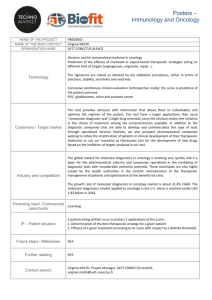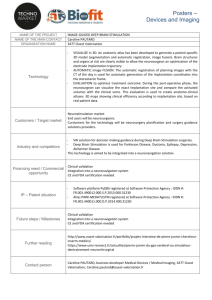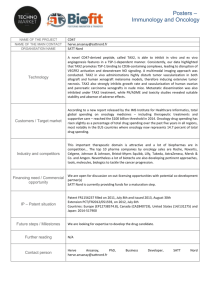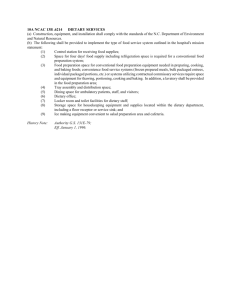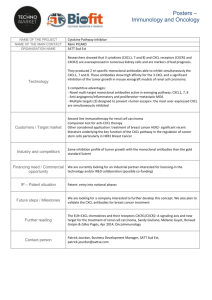PA$-{s/wHo p*f,€ey ffiegionaf, ffixp*rt ffin**xp
advertisement
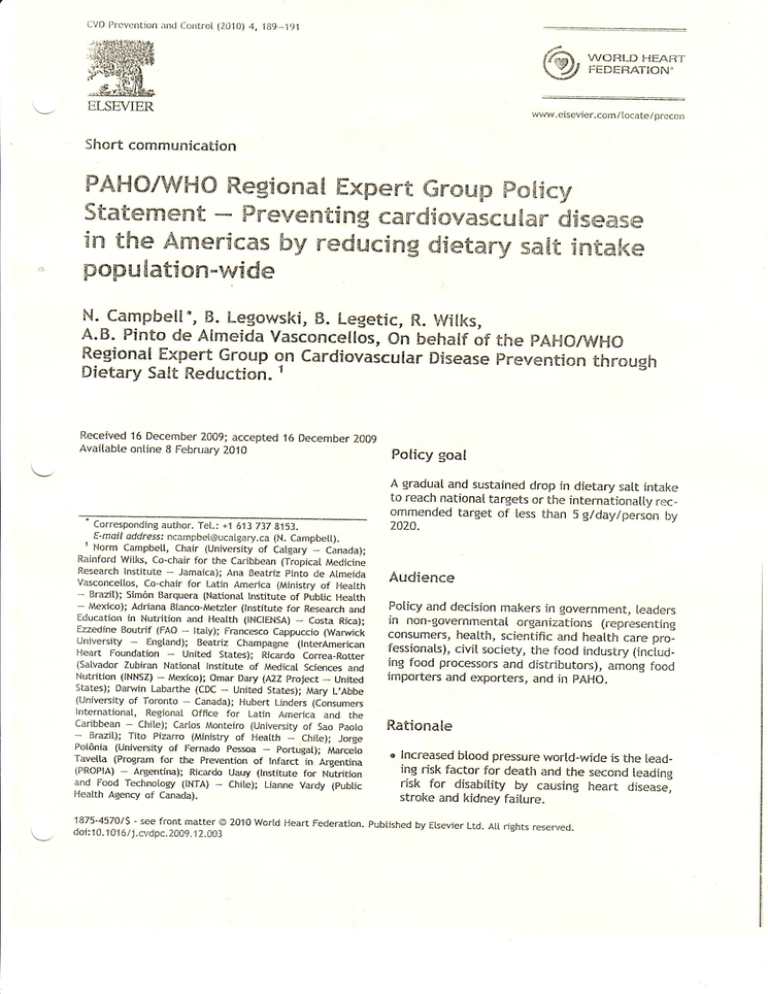
CVDPrcvcntionand Conrrol(Z01Ui4, 189*191
\^/OALD h'EAIfT
FEDFfr/TTIOru,
ELSEVIER
wwv/.e[sevier.com/ lccate/ nrecarr
Shortcommunfcation
PA$-{s/wHo
p*f,€ey
ffiegionaf,
ffixp*rtffin**xp
* Prsveratfng
Steterxl#ne
e&rd,f*v&seuflmn
ei$s#&se
,fie-atmk*
rr"lths &mlerfc&s
by neduaetmg
d{etary saf,&
p&puf,atf
mn-wids
N. Carnpbell.,B. Legowski,B. Legetic,R,.Wi{ks,
A.B. Pinto de Atmeidavasconcellos,
0n behatfof the pApfs/wplg
R'egionalExpert.Groupon CardiovascularDiseasepr-everrticnthrough
DietarySattReduction.1
Received16 December2009; accepted 16 December2009
Avai(abteonline 8 Februarv2010
Corresponding
author. Tet.: +1 613737 9153,
E-moil address:ncampbel@ucai.gary.ca
(N. Campbett).
,'
Norm Campbett, Chair (Universityof Catgary _ Canada);
Rainford Wi{ks, Co-chairfor the Caribbean{Tropical.Medicine
Researchlnstitute - Jamaica);Ana Beatriz pinto de A,tmeida
Vasconcetlos,Co-chair for Latin America (Ministry of Heatth
- Brazit); 5im6n Barquera (Nationat lnstitute
of pubtic Heal.th
- Mexico); Adriana Btanco-Me?ler (lnstitute
for Researchand
Education in Nutrition and Health (|NCIENSA)
- Costa Rica):
Ezzedine Boutrif (FAO - ltaty); FrancescoCappuccio (Warwick
University * Engtand); Beatriz Champagne
ilnterAmerican
Heart Foundation * United States); Ricardo Correa-Rotter
(Satvador Zubiran National Institute of Medicat Screncesanc
Nutrition (INNSZ)- Mexico); Omar Dary (MZ project _ United
States); Darwin Labarthe{CDC- United States); Mary L,Abbe
(Universityof Toronto * Canada);Hubert Linders (Consumers
International, Regionat Office for Latin America and the
Caribbean- Chite); CarlosMonteiro (Universityof Sao paoto
- Erazil.); Tito pizarro (Ministry of Heatth _
Chite); Jorge
PoL6nia (University of Fernado pessoa - portugat); Marcelo
Tavetla (Program for the prevention of Infarct in .Argentina
(PROPIA)- Argentira); Ricardo Uauy {lnstitute for Nutririon
and Food Technology {INTA) - Chite); Lianne Vardy (pubiic
l{eatth Agency of Canada).
Policy goal
A gradualand sustaineddrop in dietary satt intake
to reach national targets or the internationatiy rec_
ommended target of less than 5 g/daylperson by
7420.
Audience
Policy and decisionmakers in government, leaders
in non-governmentalorganizations (representing
consumers,health, scientificand health care professionats),civil society, the food industry (inctud_
ing food processorsand distributors), among food
importers and exporters, and in pAHO.
Rationale
e lncreasedbtood pressurewortd-wide is the [eading risk factor for death and the secondteading
risk for disabitity by causing hearc disease,
stroke and kidney fafture.
1875-4570/5- see front matter o 2010wortd Heart Federation.Pubtished
by EtsevierLtd. Att rights reserved.
j 2.A03
doiil 0. 1016/ j. cv dpc.21A9
190
o In th€ Americas,between 1/5 and 1/3 of att
adutts has hypertension and once age 80 is
reached, over 90% can be expected to be
hypertensive.
' ln 2001, the rnanagementof non-optimalbiood
pressurei.e. systoticpressureover 115mm Hg
consumed about 107oof the vrortd's overail
heatthcareexpenditures.
o As dietary satt consumption increases,so does
btood pressure. Typical modern diets provide
excessivearnountsof salt, from early chitdhood
through adulthoodc The recommendedintake of satt is lessthan 5 g/
daylperson. In the Americas, intake can be over
double the recommended tevet, Att age groups
including chitdren are affected.
r Addingsatt at the tabte is not the onty probtem.
In most poputationsby far the largest amount of
dietary salt comes from ready-mademeals and
pre-preparedfoods, inctuding bread, processed
meats, and even breakfast cereals.
o Reducing satt consumption poputation-wide is
one of the most cost-effective measures avaitabte to pubtic heatth. lt can tower the rates of
a number of related chronic diseasesand conditions at an estimated cost of between 50.04and
50.32 US per person per year. Popul.ation-wide
interventions can atso distribute the benefits of
heatthy btood pressureequitabty.
o Governmentsare justified in intervenfngdirectty
to reduce poputation-wide satt consumption
becausesalt additives in food are so common.
Peopteareunawareofhow muchsatttheyareeating in different foodsand of the adverseeffects on
their heatth- Chitdrenare especiattyvulnerabte.
n Satt intake can be reduced without compromising micronutrient fortification efforts.
Recommendationsfor policy and action
The recommendationsbetow are consistentwith the
WortdHeatthOrganization'sthree pittarsfor successful. dietary satt reduction: product reformu[ation;
consumerawarenessand educationcampaigns;and
environmentaIchangesto make heatthychoicesthe
easiestand most affordabteoptionsfor atl peopte.
To national governments
o Seek endorsement of this poticy statement by
ministries of hea(th, agricutture and trade, by
food regutatory agencies, nationat pubtic
heatth leaders, non-governrnentalorganizations
(NGOs), academia, and retevant food
industries.
N. Campbetlet at.
o Developsustainabte,
funded,scientificallybased
salt reductionprogramsthat are integratedjnto
existing food, nutrition, heaith and education
prograrns.The programsshoutdbe socia[{yinclusive and include major socioeconornic,racial,
culturat, genderand age subgroupsand specificaily children. Componentsshoutdinciude:
r Standardizedfood tabetingsuch that consumers can easityidentify high and tow salt foods.
r Educatingpeople inctudingchi(drenabout the
heatth risks of high dietary satt and how to
reduce salt intake as part of a heatthy diet.
r lnitiate cottaboration with retevant domestic
food industries to set graduattydecreasingiargets, with timetines, for satt levets accortling
to food categories,by regutationor througheconomic incentives or disincentiveswith government oversight.
. Regutateor otherwise encouragedomestic and
multinationa[ food enterprises to adopt the
lowest of a) best in ctass (sa[t content to
rnatch the lowest in the specific food category)
and b) best in wortd for the national rrarket
(match the lowest salt content of the specific
food produced by the company etsewhere in
the wortd).
o Devetopa nationat surveittancesystemwith regutar reporting to identify dietary satt intake tevets and the major sources of dietary satt.
Monitor progresstowards the nationat target{s)
" for dietary satt intake
or the internationail,yrecommendedtarget.
" Review national satt fortification poticies and
recommendations to be in concordance with
the recornrnendedsalt intake.
r Extendofficial support to the CodexAiimentarius committee on food labeling for salt/sodium
to be inctuded as a mandatory component of
nutrition tabels.
e Developlegistativeor regutatory frameworks to
imptement the Wortd Heatth Organization
(WHO)recommendationson advertjsingof food
products and beveragesto chitdren.
To non-governmental organizations, health
care organizations, associations of heatth
professionals
a Endorsethis poticy statement.
r Educatemembershipson the heatth risksof high
dietary satt and how to reduce satt intake.
Encourage invotvement in advocacv. Monitor
lAt-o_{Y|]*ojg gpI!! F"gg$ g ry:up PoIicy si ai emenr
and promote presentationson dietary satt at
nationaImeetingsand the pubticationof artictes
on dietary salt.
o Promote and advocate rnedia releaseson dieiary salt reduction to reach the pubtic, inctuding chitdren and particularty $/omen given
their integrat rotes in famity heatth and food
preparation.
" Broadtydisseminateretevantliterature.
s Educate poticy and decision makers on the
heatth benefits of lowering btood pressure
among normotensive and hypertensive people,
regardtessof age.
e Advocate poticfesand regutationsthat wiit contribute to poputation-widereductjonsin dietary
satt.
* Promote coatition building, increase organizational capacity for advocacyand devetop advocacy toots to promote civil scciety actions.
To the food industry
r Endorsethis poticy statement.
' Makecurrent best in ctassand best in wortd [ow
satt products and practices universat across
gl.obatmarketsas soonas possibte.Makesatt substitutes readityavailabteat affordabte prices.
c Institute reformu(ationschedutesfor a gradual
and sustainedreduction in the salt content of
a[[ existing satt-containingfood products, restaurant and ready-mademeats to contribute to
achievingthe internationalty recommendedtarget or nationat targets where applicabte. Make
att new food product formutations inherenttv
[ow in salt.
r Use standardized,ctear and easy-to-understand
food labets that inctude information on satt
c0ntent.
r Promote the heatth benefits of low satt diets to
atl peoptesof the Americas.
191
To the Pan Annerican Heelth Srganization
" fnsure good communicationsand informatron
sharingbetween regionaland internationalinitiatives to foster best practices.
e Developa temptatefor nationalreport cardsand
report to Member States on comparative
nationat basetinesand progressat pre specified
time points (e.g. in 2010 the basetine,progress
in 2015and 2020).
e Work with MemberStatesto monitor dietary satt
consumptionin the Americas.
c Devetopand foster a network of endorsinggovernments,NGOs,and expert championson dietary satt in the Pan American region.
' Developa web based .toolbox' with educational
materials and programs on dietary satt for the
public, patients, heatth care professionals
that
are cutturattyappropriateto sub-regionsof the
Americas.
Developand advocateconflict of interest gr:.icie"
lines to assistheatth organizationsand scientists
in the PanAmericanregionin their interactions
with the food industry.
o Foster research on the economic and heatth
impacts of high dietary satt in the couniries
and sub-regionsof the pan Americanresion.
o AssistMemberStatesto revisenationalind subregional fortification prograrnsto be consistent
with efforts to reduce dietary satt.
o Cottaboratewith the Foodand AgricuttureOrganization(FAO),UNICEF,the CcdexAtimentarius
Commissionand other retevant UN bodies to
achieve a consistent and coordinated approach
to reducingdietary satt.
r Educate poticy and decision makers on the
health benefits of lowering btood pressure
among normotensive and hypertensive people,
regardlessof age.
o Advocate policies and regutationsthat witt contribute to poputation-widereductionsin dietarv
satt.
Availableonlineat www.sciencedirect.com
'il-*l'
S*enceDirect
